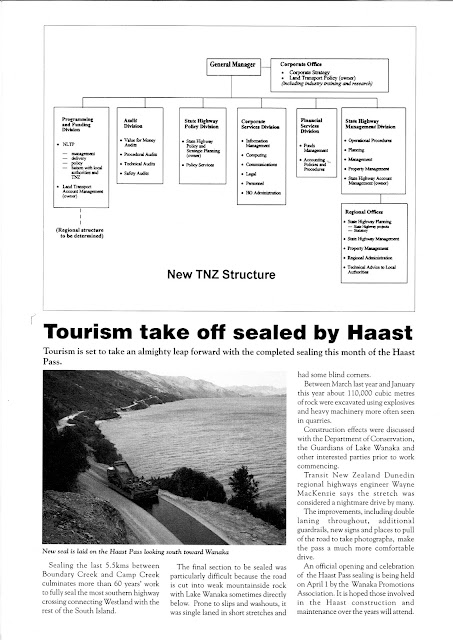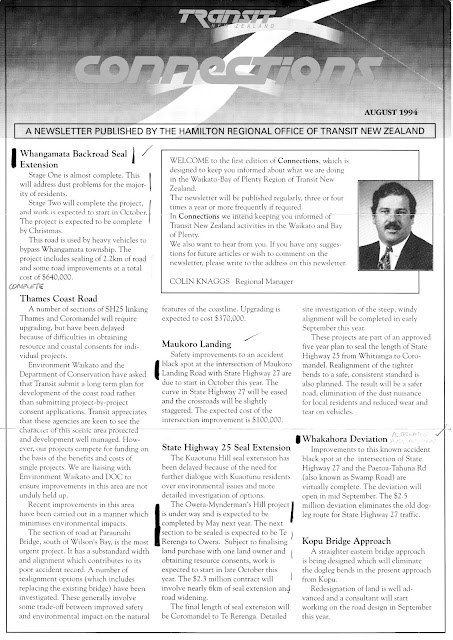 |
| In Transit February 1994 |
Hard as it is to believe, but the state highway network is to this day not fully sealed. Ten km of State Highway 43 is not sealed today in 2023, although funding to address this was approved in 2019. State Highway 43. Two of the twelve kilometres of the highway has been sealed recently, and the remaining work will be completed in 2024. This has taken quite some time, as the InTransit newsletter from the then State Highway manager (and funding agency), Transit New Zealand indicated. Transit New Zealand wanted to seal all of the state highways by 2002, with this headline story noting that SH87 Dunedin to Middlemarch, SH38 to Lake Waikaremoana and SH43 Stratford to Taumarunui had not been sealed.
However, these weren't the priority. Top priority was SH6 Haast Pass, which is extraordinary as this is the only road connection from the West Coast to Otago and Southland. This was followed by SH12 through the Waipoua Forest and SH25 around the Coromandel Peninsula. It is rather extraordinary to think that these roads were unsealed in considerable part 30 years ago.
SH6, SH12 and SH25 had sealing completed in the subsequent eight years, but SH87, 38 and 43 took more time.
SH87 Dunedin to Middlemarch was sealed in the late 1990s, noting that it had been neglected in part because the Otago Central Railway was seen as the key corridor, but that had been closed in 1990 and the remaining segment used for tourist excursions. There was definitely an element of political decision making to put some road improvements on a low priority to try to save rail. A similar argument would have been made around SH43 Stratford to Taumarunui which until recently had a relatively well used railway line in operation, connecting Taranaki to Waikato and Auckland (with passenger rail service operating until 1983), and which until the 1990s had a freight terminal at Ohura. That railway line is mothballed, but undoubtedly its presence would have seen proposals to seal the parallel state highway as appearing to be wasteful.
SH38 Lake Waikaremoana was sealed subsequently, although it is important to remember that 198km of the route through the Urewera National Park is not state highway and is unsealed.
SH43 Tangarakau Gorge remains partly unsealed.
The attached report reflects a survey undertaken of local authorities and the tourism sector on priorities for sealing roads, at a time of tight budgets. Notable was priority given to sealing Glenorchy Road around Lake Wakatipu in Queenstown, and the Crown Range route, all of which proceeded in the 1990s as growth in tourism was seen as a national priority. The Catlins route along the Otago-Southland coastline is also included in this and has no doubt opened up that scenic region to many more visitors (and again much of that area had a railway line until 1971 that would have influenced political decision making around upgrading a road when a marginal railway line was in operation).
It is worth noting that at this time, when the funding threshold for road projects was high (a benefit-cost ratio of better than 5:1 required) sealing the state highways was seen as a strategically important project even though it had a poor BCR. In most cases the benefits were seen as mainly being reduced maintenance costs over 25 years, improved travel times and some improved safety, but wider economic benefits were not included in appraisal. It might be argued that having sealed these roads they induced more traffic which increased economic opportunities for tourism-supported businesses much further afield (e.g. encouraging self-drive travel between the West Coast and Wanaka/Queenstown).
This is a reminder of the strict austerity around road capital spending by central government at this time, and indeed ho much government historically did not spend significantly on many state highways over decades if they were not seen as economically or politically significant.








































